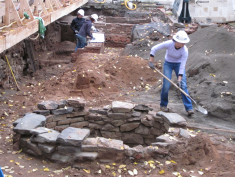Feature 28 was found during the 2010 City Hall Park excavations. It was located in West Path North and is the largest midden (in terms of number of artifacts) excavated in City Hall Park to date. It was disturbed by a series of modern utility conduits, which impacted the depth it began at in some locations. It is believed to be roughly rectangular or ovular, though the full extent of the feature is not known.
Feature 28 is a midden, or trash pit, with a high density of artifacts. 8,933 artifacts and 11,292 faunal remains were found in it– 20,225 in total. The deposits have been dated to the first decade of the 19th century, before or during the construction of City Hall in 1803-1811. There are some outlying artifacts that have been dated to later which are considered to be intrusions. The faunal fragments contained a large number of mollusk, clam, and oyster shells, though the remains came from a variety of animals. The non-faunal artifacts had a high proportion of household goods, containing many smoking pipes, ceramic wares, and alcohol bottles. Feature 28 consists of four strata, deposited in four episodes.
There is evidence that indicates the artifacts present in Feature 28 were deposited by the construction workers building City Hall, as well as the prisoners and staff of the Bridewell, a nearby prison. It is unlikely that it was used by the wider community due to its location.
The assemblage of Feature 28 appears to be the product of primary, short-term deposits, perhaps because of clean-up before the opening of City Hall in 1811 or because of the yellow fever epidemic of 1805. This feature reflects the shift of City Hall Park from public to private land.
-
Soil description
Historic fill





